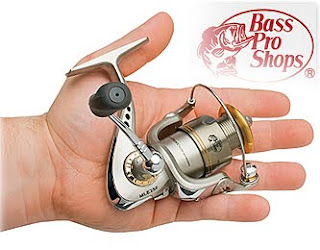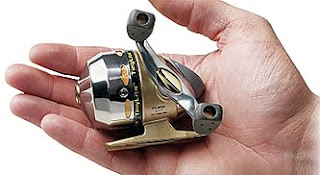The night before the picnic I got my tackle together. It all had to be rather inconspicuous – like it was a second thought - like I didn’t come prepared for a full day of fishing. I finally decided on one of my light action telescopic rods (collapses nicely) and coupled it with a small spinning reel and thin diameter super line. My lure of choice was never in doubt, as I needed something that could fit into my pocket yet put some fish in my hands - Strike King’s Mini-King Spinnerbait.
Small water? Not a problem. Pack an army of mini safety-pin soldiers!
Upon arrival at the picnic grounds I found the lake to be exactly as advertised – fed by a country stream, this little jewel was dotted in lily pads and lined with trees, some of them fallen. I settled my family at a picnic table, got the kids off to the jumpy tent, and then excused myself to the water, rod in hand (my wife promised to save me a plate full o’ juicy barbeque). The second cast I made with the Mini King netted me a two pound bass. Immediately I drew an audience, with most onlookers asking the exact same questions – There’s fish in this lake? Really? Why are you letting them go? My sixth cast netted me another nice two plus pound fish and more observers, some of them wishing aloud that they had packed a rod and reel. An hour later the Mini King’s work was done; I had caught four Largemouth, including a bonus Rockbass and Bluegill, and had entertained a large number of picnic goers with my display of seemingly impromptu angling virtuosity. I also ate very well that day, and the kids and wife had a ball - Win, win and win.
Topwater Bottom Line: The Mini-King Spinnerbait has proven itself time and time again to not only produce bass on small water, but big bass on commonly fished big water; It’s a fact, smaller profile lures produce on pressured lakes. I’ve personally out fished multiple anglers throwing big spinnerbaits in the same bay on the same day with my Mini-Kings - to their immediate chagrin I might add. With reference to smaller water, the importance of not alarming other fish with your presentation cannot be over emphasized, and therefore a lightweight, light-splash bait is ideal. Also, it stands to reason that bass in smaller water will feed on smaller prey items, and therefore you should mimic in-kind. Strike king offers a wide variety of colors, but my favorite is White Diamond Dust – a fantastic all-around shad/baitfish imitator. I also keep a Red or Black/Blue Diamond Dust Mini-King for overcast or low-light conditions handy. Each Mini-King Spinnerbait is outfitted with a 2.1 size silver Tennessee diamond plate blade for maximum flash and vibration. The bait's jig head is also diamond-dust treated and is outfitted with a metal flaked silicone skirt. A good tip here is to trim the skirt (something I do on all my spinnerbaits) by cutting off a half, to a full thumbnail’s worth of length - I’ve found this increases hook ups. Though the Mini-King does sport a fairly large hook – a testament to its big fish catching potential – I don’t suggest adding a plastic trailer as I feel it compromises the overall presentation. The cost is very reasonable at $3.39 per unit, and at this price you can afford to keep an entire stable of these little baits at the ready. The mini spinnerbait market is a segment that has not been fully taken advantage of in the industry – with few big fish producing options readily available to the angler (Booyah, Johnson and Strike King being the exceptions I’ve found). As always, please practice catch and release with these lures.
Topwater Rating:
5 out of 5 bobbers
Always effective, always efficient - Strike King’s Mini-King Spinnerbait

































